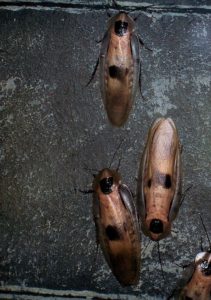 Baits are the primary pesticides used to treat cockroach infestations. They can be packaged as pastes, gels, granules, or dusts. Most insecticides used in baits are slow acting. Consequently, an effective bait program does not give immediate results, but may take 7 days or longer to provide visual evidence of its effects. Baits can be quite effective for long-term control of cockroaches unless the cockroaches have other food sources available to them.
Baits are the primary pesticides used to treat cockroach infestations. They can be packaged as pastes, gels, granules, or dusts. Most insecticides used in baits are slow acting. Consequently, an effective bait program does not give immediate results, but may take 7 days or longer to provide visual evidence of its effects. Baits can be quite effective for long-term control of cockroaches unless the cockroaches have other food sources available to them.
Baits do not control all cockroaches equally. Female cockroaches with egg cases do very little feeding and avoid open spaces; consequently, they are less likely to be immediately affected by a bait.
Bait Stations:
Prefilled bait stations is the most popular form for home use, which are small plastic units that contain an attractive food base along with an insecticide. Refillable bait stations are available in stores and are refilled with bait granules or gel. The advantage of bait stations is that insecticides can be confined to a small area rather than being dispersed, and they are relatively child resistant. Baits in plastic containers also remain effective for many months.
Gel Bait:
Gel baits are very effective for crack and crevice treatments when applied using a bait gun or syringe in small dabs in cracks and crevices where cockroaches will find it. While they are fresh, bait gels are very effective when placed in locations where they will be found by cockroaches. To remain effective, however, the gels need to be reapplied frequently. Bait gels dehydrate in about 3 days when left in open air, it is therefore recommended that gels be used indoors only.
Baits that are available to homeowners can usually be purchased at most retail outlets that carry garden supplies. Examples include Stapleton’s Magnetic Roach Food by Blue Diamond, Combat gel bait and prefilled bait stations, and Pre-Empt Professional Cockroach Gel Bait. These products may vary in effectiveness according to cockroach species.
As with sticky traps, insecticidal baits do not attract cockroaches so place them near hiding spaces or where roaches are likely to encounter them when foraging. If the bait stations are labeled for outdoor use, place them around building perimeters, in valve or water meter boxes, and around planters. Indoors, place bait packets under or behind appliances, along wall borders, and in cabinets. Baits can also be placed next to fecal specks and droppings of cockroaches, which contain a natural attractant or aggregation pheromone. Look for these fecal specks and droppings under kitchen counters, behind kitchen drawers, and in the back of cabinets.
In summary, Baits are most highly recommended because of their effectiveness and targeted application, decreasing unnecessary pesticide exposure. Baits usually come in granular formulations, plastic stations, or large syringes for gel applications. Apply granular formulations outside in plants and mulched areas, bait stations should be placed in areas where you suspect cockroaches are hiding in your home, the gel in syringes will be placed in cracks and crevices around windows, doors, and any other suspected cockroach harborage.

